- Verbena: The Ultimate Guide to Growing and Caring for this Beautiful Garden Plant
- Introduction
- Types and Varieties
- Growing Verbena
- Caring for Verbena
- Conclusion
- Why Choose Verbena: Benefits and Advantages for Your Garden
- 1. Colorful Blooms
- 2. Long Blooming Season
- 3. Low Maintenance
- 4. Attracts Pollinators
- 5. Versatile Plant
- 6. Disease Resistance
- How to Grow Verbena: Essential Tips and Tricks for Success
- Choosing the Right Location
- Preparing the Soil
- Planting Verbena
- Watering
- Fertilizing
- Deadheading
- Overwintering
- Common Pests and Diseases
- Conclusion
- Varieties of Verbena: Explore the Diverse Options for Your Garden
- 1. Homestead Purple Verbena
- 2. Tapien Verbena
- 3. Lanai Verbena
- 4. Buenos Aires Verbena
- 5. Tuscany Verbena
- 6. Quartz XP Verbena
- 7. Superbena Verbena
- 8. Vamp Verbena
- Conclusion
- Top 5 Colorful Verbena Varieties to Enhance Your Garden
- Lollipop Verbena
- Homestead Purple Verbena
- Moonlight Verbena
- Tapien Blue Violet Verbena
- Appleblossom Verbena
- Verbena in Containers: Create Stunning Displays with Potted Verbena
- Why Grow Verbena in Containers?
- How to Grow Verbena in Containers
- Container Verbena Varieties
- Verbena Care: Proven Techniques to Keep Your Plants Healthy
- 1. Sunlight
- 2. Watering
- 3. Soil
- 4. Fertilization
- 5. Pruning
- 6. Pest and Disease Control
- 7. Mulching
- 8. Winter Care
- Questions and Answers:
- What are the different types of verbena plants?
- How do you grow verbena plants in the garden?
- What are the best companion plants for verbena?
- Can verbena plants be grown in containers?
- What are the benefits of growing verbena plants?
- How often should I water my verbena plants?
- How do you propagate verbena plants?
- Videos: Growing Beautiful Verbena Flowers — and a Tour of Blooms
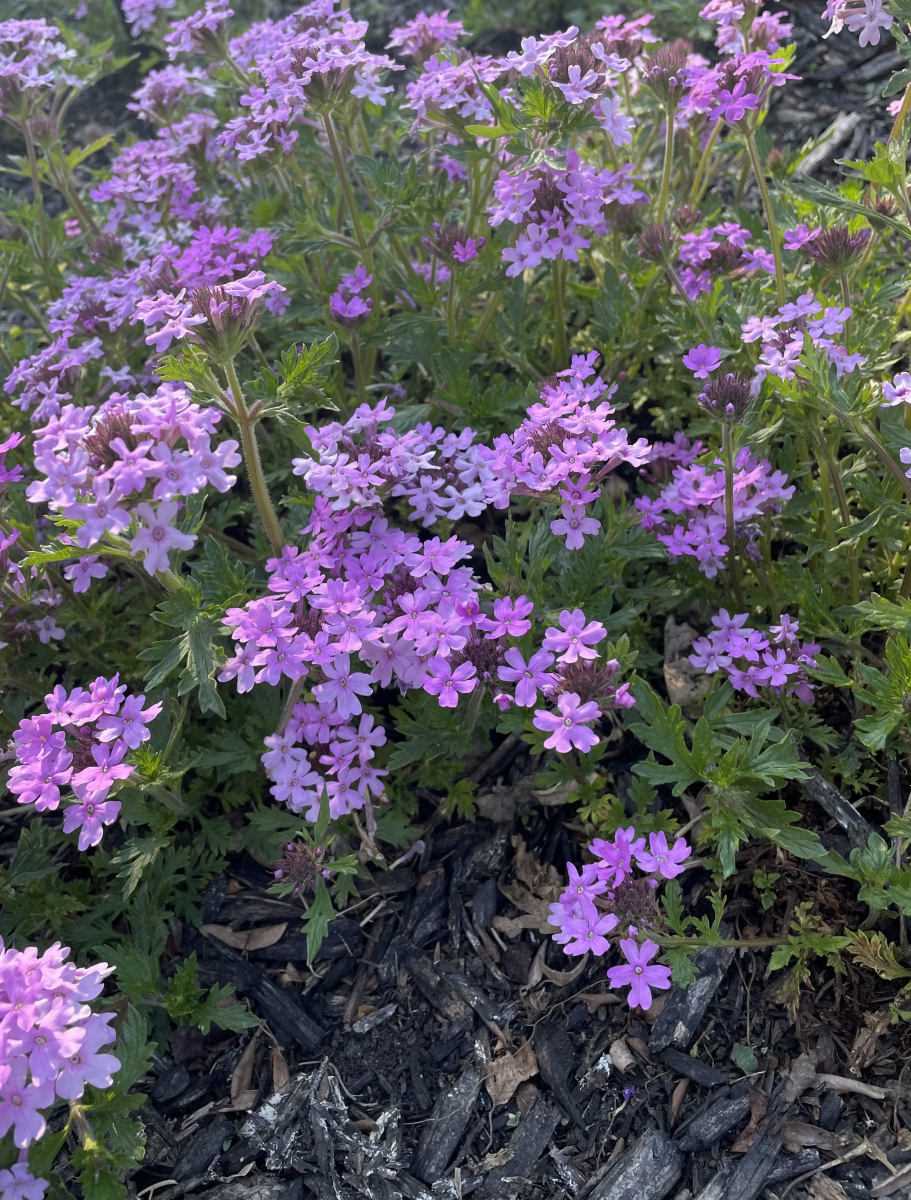
Verbena is a popular flowering plant that can add a splash of color to any garden. With its vibrant blooms and delicate foliage, it is easy to see why this plant is a favorite among gardeners.
Verbena comes in a variety of types and varieties, each with its own unique characteristics and requirements. From creeping verbena to tall verbena, there is a type of verbena for every garden.
If you are looking to grow verbena in your garden, there are a few important things to consider. First, verbena thrives in full sun, so be sure to choose a sunny spot in your garden. Additionally, verbena is a low-maintenance plant, making it perfect for beginner gardeners or those with limited time for gardening.
When it comes to selecting a variety of verbena for your garden, the possibilities are virtually endless. Some popular varieties include V. bonariensis, with its tall, slender stems and clusters of tiny purple flowers, and V. canadensis, which features bright red flowers and grows well in containers.
No matter which type or variety you choose, verbena is sure to be a beautiful addition to your garden. Its vibrant colors and sweet fragrance will attract pollinators and bring joy to your outdoor space. So why not give verbena a try and see the difference it can make in your garden?
Verbena: The Ultimate Guide to Growing and Caring for this Beautiful Garden Plant
Introduction
Verbena is a stunning garden plant known for its vibrant flowers and delicate foliage. This versatile plant comes in a variety of types and varieties, making it a popular choice for gardeners of all skill levels. In this guide, we will explore everything you need to know about growing and caring for verbena in your garden.
Types and Varieties
Verbena is a genus that encompasses several different species, each with its own unique characteristics. Some of the most popular types of verbena include:
- Common Verbena (Verbena officinalis): This is the most common variety of verbena and is often used for medicinal purposes.
- Homestead Purple Verbena: Known for its deep purple flowers, this variety is a favorite among gardeners.
- Tapien Verbena: With its trailing habit and eye-catching flowers, Tapien verbena is perfect for hanging baskets and containers.
- Princess Verbena: This variety produces large, showy flowers in a range of colors, adding a touch of elegance to any garden.
Growing Verbena
Verbena is a relatively easy plant to grow, making it great for beginners. Follow these steps to successfully grow verbena in your garden:
- Choose a sunny location: Verbena thrives in full sun, so make sure to select a spot in your garden that receives at least 6 hours of direct sunlight each day.
- Prepare the soil: Verbena prefers well-draining soil, so amend the soil with compost or organic matter to improve drainage.
- Sow the seeds or transplant the seedlings: Depending on the variety, you can either start verbena from seeds or purchase young plants from a nursery.
- Water regularly: Verbena prefers consistently moist soil, so water regularly to keep the soil evenly moist, especially during dry periods.
- Prune as needed: To encourage bushier growth and more blooms, prune verbena plants back by about one-third in midsummer.
Caring for Verbena
While verbena is relatively low-maintenance, it still requires some basic care to ensure its health and longevity. Here are some essential care tips to keep in mind:
- Watering: Water verbena regularly, especially during dry spells, but avoid overwatering, as this can lead to root rot.
- Fertilizing: Feed verbena plants with a balanced slow-release fertilizer once a month during the growing season to promote healthy growth and abundant blooms.
- Deadheading: Remove spent flowers regularly to encourage continuous blooming throughout the season.
- Pest and disease control: Keep an eye out for common pests like aphids and whiteflies, and treat them promptly with natural or chemical controls.
Conclusion
With its beautiful flowers and easy-growing nature, verbena is a fantastic addition to any garden. Whether you choose a classic variety or opt for a more unique type, growing and caring for verbena is a rewarding experience that will add a splash of color to your outdoor space.
Why Choose Verbena: Benefits and Advantages for Your Garden
Verbena is a popular flowering plant that offers numerous benefits and advantages for your garden. Whether you have a small balcony garden or a sprawling backyard, verbena can enhance the beauty and appeal of your outdoor space. Here are some reasons why you should consider adding verbena to your garden:
1. Colorful Blooms
One of the main reasons to choose verbena for your garden is its vibrant and colorful blooms. Verbena flowers come in a wide variety of hues, including shades of pink, purple, red, and white. These eye-catching blooms can add a pop of color to your garden and create a visually stunning display.
2. Long Blooming Season
Another advantage of verbena is its long blooming season. Depending on the variety, verbena can bloom from spring to fall, providing you with months of beautiful flowers. This extended blooming period ensures that your garden remains vibrant and lively throughout the growing season.
3. Low Maintenance
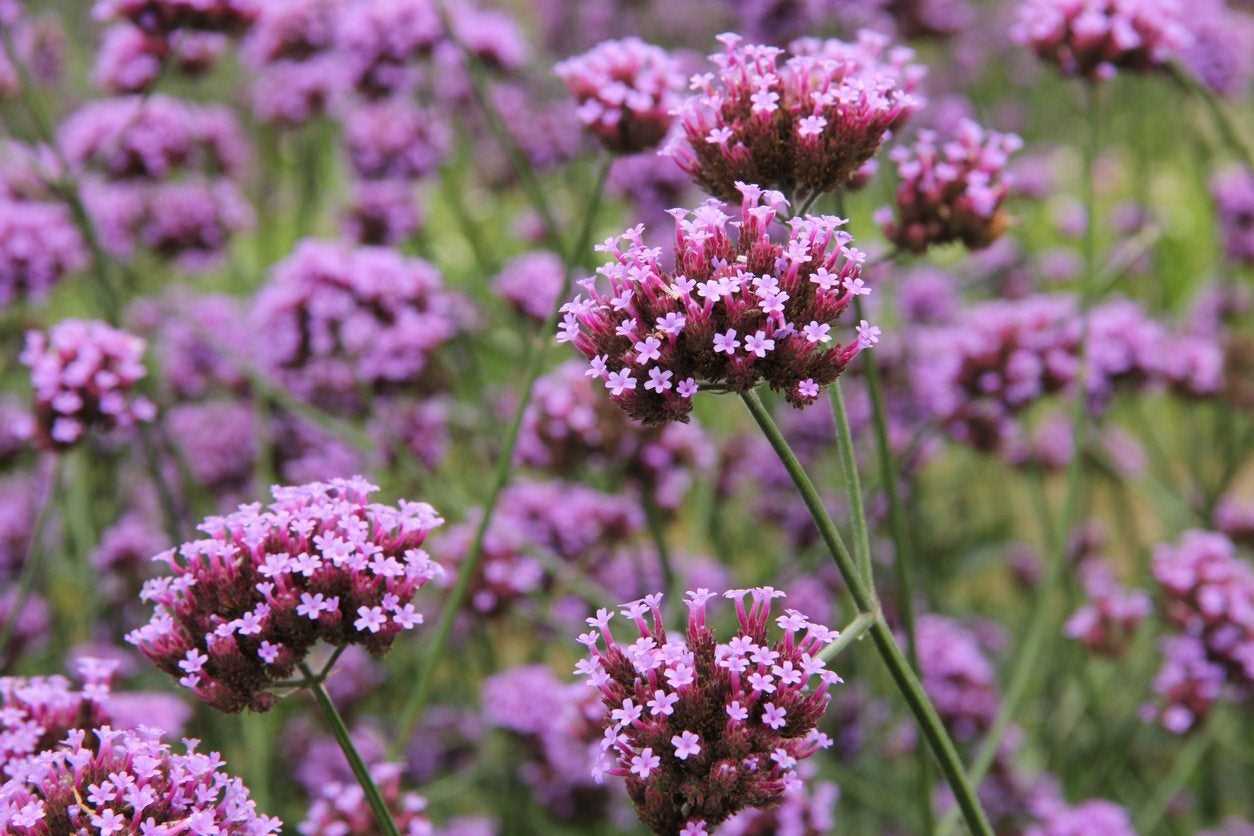

Verbena is a low-maintenance plant, making it an excellent choice for both experienced gardeners and beginners. It requires minimal care and can thrive in a variety of conditions. Verbena is drought-tolerant and can handle hot, dry summers, making it an ideal choice for gardens in regions with limited rainfall.
4. Attracts Pollinators
Verbena flowers are known for attracting pollinators such as bees and butterflies. By adding verbena to your garden, you can create a welcoming environment for these beneficial insects. The presence of pollinators can help promote a healthy ecosystem and improve the overall productivity of your garden.
5. Versatile Plant
Verbena is a versatile plant that can be used in various ways in your garden. It can be planted in flower beds, containers, hanging baskets, or used as a ground cover. Its trailing growth habit makes it a great choice for cascading over edges and adding a touch of elegance to your garden.
6. Disease Resistance
Many varieties of verbena have natural disease resistance, making them less susceptible to common garden diseases. This means less time spent on pest control and maintenance, allowing you to enjoy your garden more.
In conclusion, verbena is a beautiful and versatile plant that brings numerous benefits to your garden. From its colorful blooms and long blooming season to its low maintenance requirements and ability to attract pollinators, verbena is a fantastic choice for any garden. Whether you have a small space or a large garden, consider adding verbena to enhance the beauty and enjoyment of your outdoor space.
How to Grow Verbena: Essential Tips and Tricks for Success
Choosing the Right Location
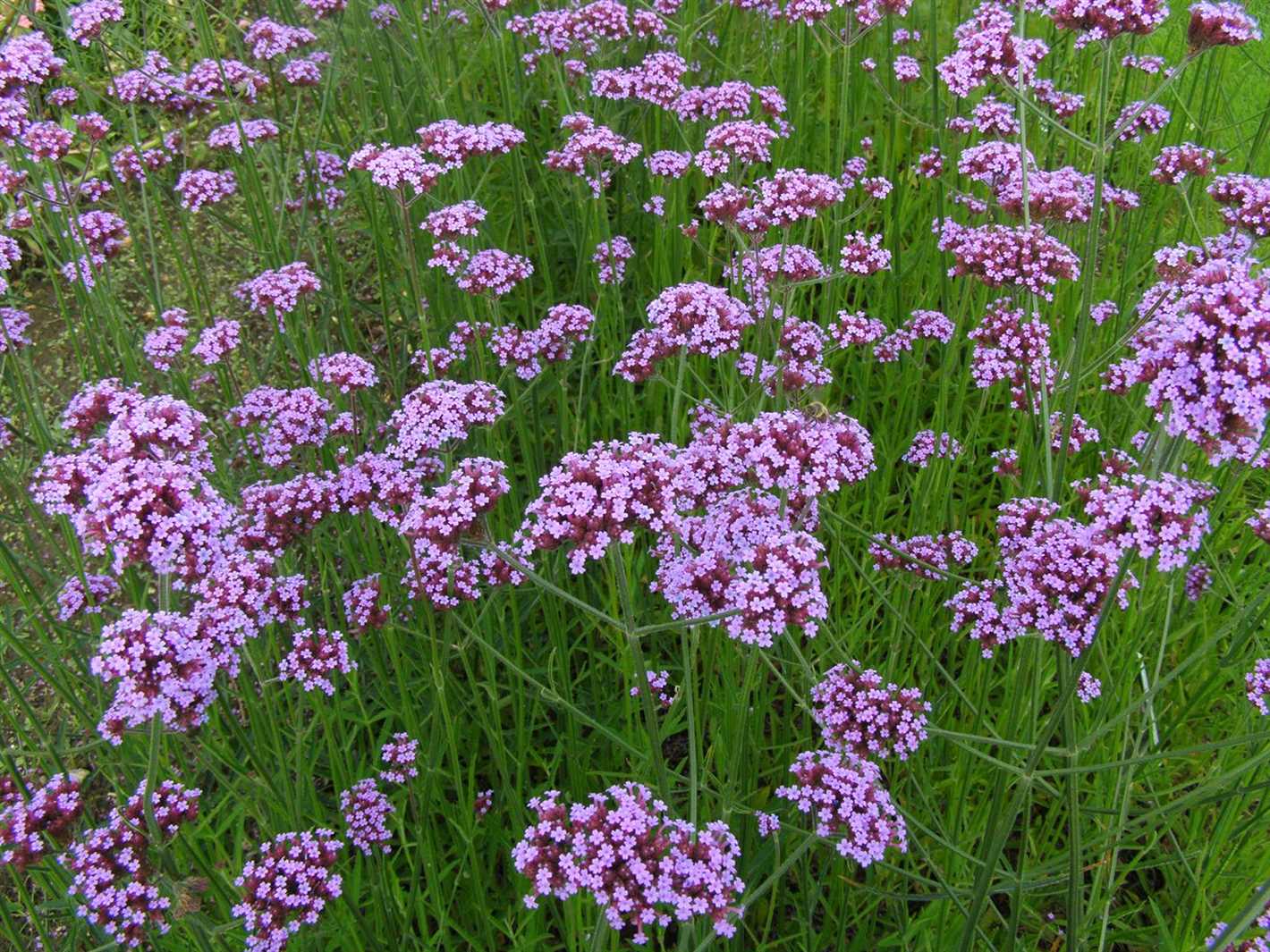

Verbena plants thrive in full sun, so choose a location that receives at least 6-8 hours of direct sunlight each day. It’s also important to select a well-draining soil for the best results.
Preparing the Soil
Before planting verbena, it’s essential to prepare the soil properly. Clear the area of any weeds or debris and amend the soil with organic matter, such as compost or well-rotted manure. This will improve the soil’s fertility and drainage.
Planting Verbena
Plant verbena in early spring after the danger of frost has passed. Dig a hole slightly larger than the root ball and place the plant in the hole, making sure it’s at the same depth as it was in the container. Backfill the hole with soil, gently firming it around the plant.
Watering
Verbena plants have moderate water needs. Water the plants deeply once or twice a week, depending on the weather conditions. It’s essential to water at the base of the plant to avoid wetting the foliage, which can increase the risk of disease.
Fertilizing
Feed verbena plants with a balanced fertilizer every 4-6 weeks during the growing season. This will provide the necessary nutrients for healthy growth and abundant flowering. Be sure to follow the instructions on the fertilizer packaging for proper application.
Deadheading
To prolong the flowering period, deadhead verbena regularly by removing faded flowers. This encourages the plant to produce more blooms and prevents it from going to seed too quickly.
Overwintering
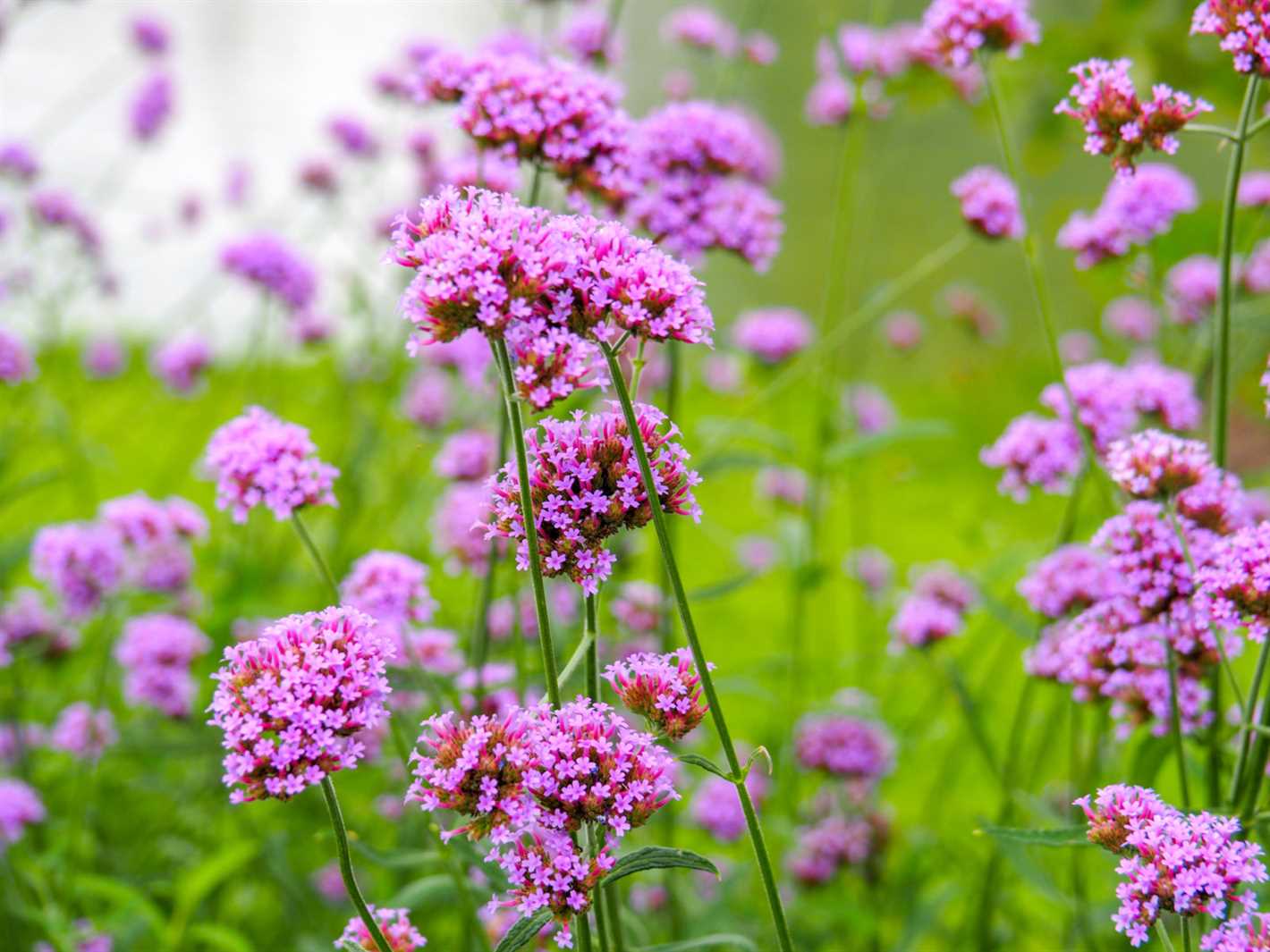

In colder climates, verbena is often grown as an annual. However, it is a perennial in warmer regions. To overwinter verbena, cut it back to a few inches above the ground after the first frost. Mulch the area with a thick layer of straw or compost to protect the plant from freezing temperatures.
Common Pests and Diseases
Verbena plants are generally resistant to pests and diseases. However, they can occasionally be susceptible to aphids, spider mites, and powdery mildew. Monitor the plants regularly and treat any signs of infestation or disease immediately to prevent further damage.
Conclusion
By following these essential tips and tricks, you can successfully grow verbena in your garden. With its beautiful blooms and attractive foliage, verbena is sure to add color and charm to any landscape.
Varieties of Verbena: Explore the Diverse Options for Your Garden
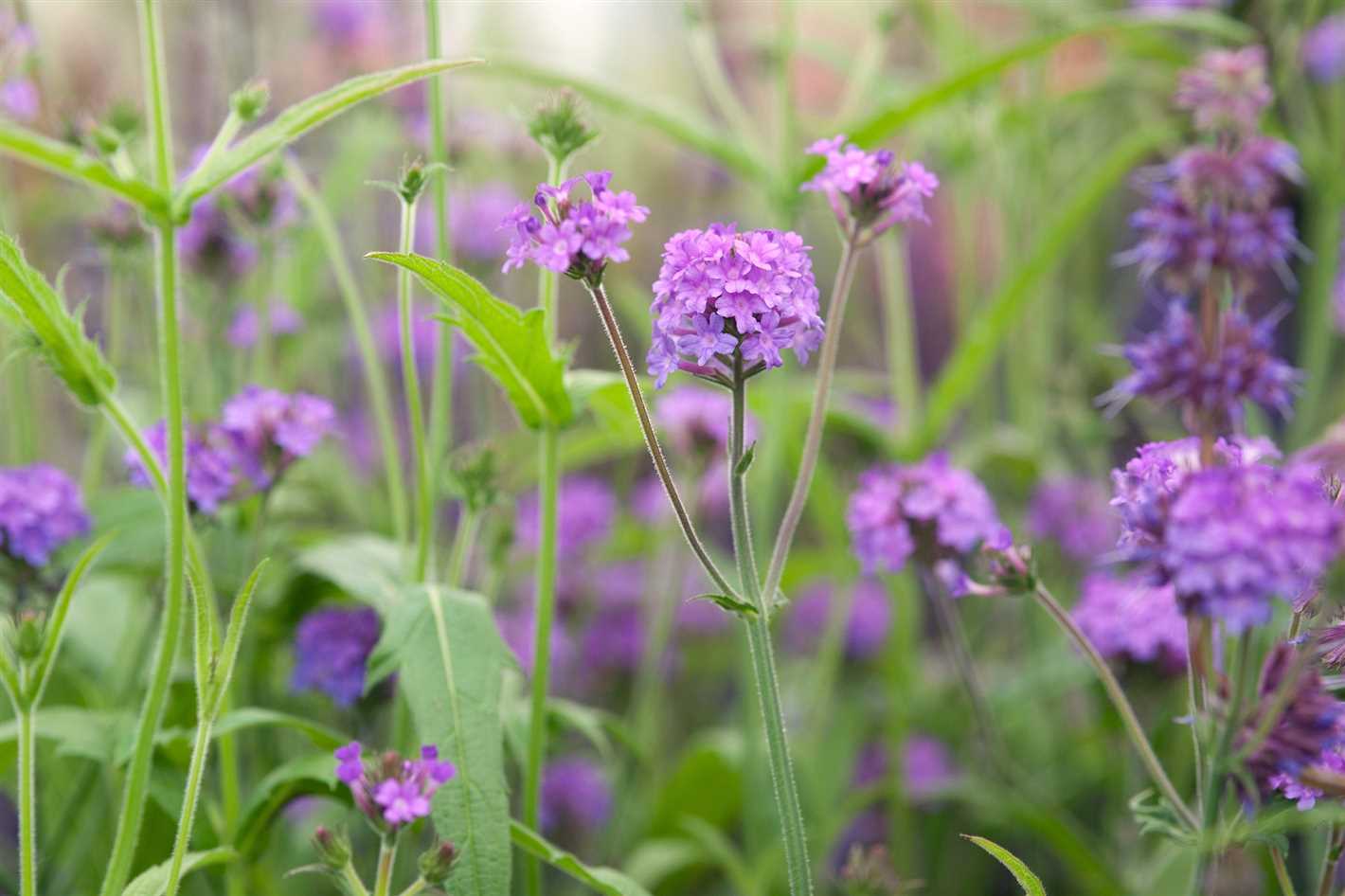

When it comes to growing verbena in your garden, you’ll be delighted to discover the wide range of varieties available. From vibrant colors to different growth habits, verbena offers something for every type of garden. In this article, we will explore some of the most popular varieties of verbena that you can consider for your garden.
1. Homestead Purple Verbena
The Homestead Purple Verbena is a stunning variety that features dark purple flowers. It is known for its ability to withstand tough conditions such as heat and drought. This variety is a vigorous grower and produces abundant blooms throughout the summer months.
2. Tapien Verbena
The Tapien Verbena is a low-growing variety that is perfect for cascading over walls or hanging baskets. It features bright and cheerful flowers in shades of pink, purple, red, and white. This verbena is known for its excellent heat tolerance and long blooming period.
3. Lanai Verbena
The Lanai Verbena is a compact and mounding variety that is ideal for borders or containers. It produces clusters of colorful flowers in shades of red, purple, pink, and white. This verbena is highly resistant to diseases and is an excellent choice for gardeners looking for a low-maintenance option.
4. Buenos Aires Verbena
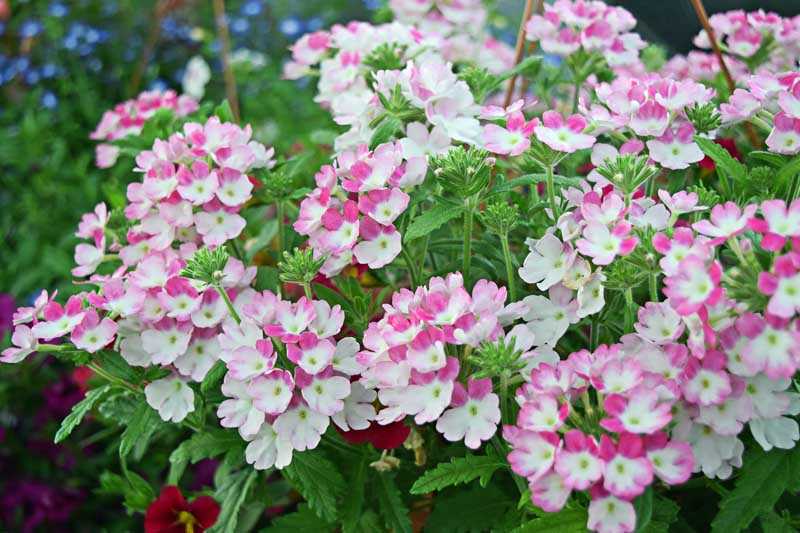

The Buenos Aires Verbena is a tall and upright variety that adds vertical interest to your garden. It features clusters of small, tubular flowers in shades of purple. This verbena is a magnet for butterflies and hummingbirds and is a great addition to wildlife-friendly gardens.
5. Tuscany Verbena
The Tuscany Verbena is a trailing variety that is perfect for containers or hanging baskets. It has large, bright flowers in shades of red, purple, and pink. This verbena is known for its abundant blooms and long trailing stems that add a cascading effect to your garden.
6. Quartz XP Verbena
The Quartz XP Verbena is a series of hybrid varieties that are known for their uniform growth and vibrant colors. They are available in a wide range of colors, including shades of purple, pink, red, and white. This verbena is heat and drought-tolerant, making it an excellent choice for hot and dry climates.
7. Superbena Verbena
The Superbena Verbena is a series of hybrids that are bred for their improved disease resistance and long blooming period. They produce an abundance of flowers throughout the summer, and the colors range from vibrant pinks and purples to soft pastels.
8. Vamp Verbena
The Vamp Verbena is a unique variety that stands out with its dark purple flowers. It is a vigorous grower and is well-suited to containers or hanging baskets. This verbena is a great choice for adding a touch of drama and contrast to your garden.
Conclusion
As you can see, there are numerous varieties of verbena to choose from, each with its own unique characteristics. Whether you prefer compact mounding types, trailing varieties, or tall upright plants, there is a verbena variety that will suit your garden’s needs. Experiment with different varieties to create a stunning and diverse display of verbena in your garden.
Top 5 Colorful Verbena Varieties to Enhance Your Garden
Verbena is a beautiful flowering plant that can add a pop of color to any garden. With its vibrant blooms and long-lasting flowers, it is a favorite among gardeners. Here are five colorful verbena varieties that are sure to enhance your garden:
Lollipop Verbena
The Lollipop Verbena variety is known for its clusters of small, round flowers in shades of pink, purple, and white. It has a compact growth habit, making it perfect for borders or container gardens.
Homestead Purple Verbena
The Homestead Purple Verbena variety is prized for its deep purple blooms and its ability to attract butterflies and hummingbirds. It is a heat-tolerant variety that can withstand the hot summer months.
Moonlight Verbena
The Moonlight Verbena variety is unique with its pale yellow flowers that bloom in late spring and summer. Its delicate blooms and trailing growth habit make it a stunning addition to hanging baskets or cascading over walls.
Tapien Blue Violet Verbena
The Tapien Blue Violet Verbena variety is admired for its beautiful, deep violet flowers that bloom throughout the summer. It is a low-growing variety that works well as a groundcover or trailing over the edges of containers.
Appleblossom Verbena
The Appleblossom Verbena variety is known for its delicate, pastel pink flowers that resemble apple blossoms. It is a compact variety that is perfect for small spaces or mixed borders.
These colorful verbena varieties are just a few examples of the wide range of options available. Whether you prefer bright and bold or soft and pastel colors, there is a verbena variety to suit your garden’s style. Planting these vibrant flowers will surely enhance the beauty of your garden.
Verbena in Containers: Create Stunning Displays with Potted Verbena
Why Grow Verbena in Containers?
Verbena is a versatile plant that can be grown in containers to create stunning displays in your garden or on your balcony. There are many reasons why you might choose to grow verbena in containers:
- Limited space: If you have a small garden or limited outdoor space, growing verbena in containers allows you to enjoy this beautiful plant without taking up too much room.
- Easy maintenance: Verbena is a low-maintenance plant, and growing it in containers makes it even easier to care for. You can easily move the pots around to find the best sun exposure and watering is more controlled.
- Design possibilities: Growing verbena in containers gives you the freedom to create stunning displays by mixing different varieties and colors. You can experiment with different container sizes, shapes, and materials to create a unique and eye-catching arrangement.
How to Grow Verbena in Containers
Here are the steps to grow verbena in containers:
- Choose the right container: Select a container that has drainage holes to prevent waterlogging. The size of the container will depend on the variety of verbena you want to grow and the available space.
- Use well-draining soil: Fill the container with a high-quality potting mix that drains well. Verbena prefers soil that is slightly acidic and sandy, so you may need to amend the soil with organic matter or sand.
- Plant the verbena: Dig a hole in the soil and place the verbena plant in the center. Make sure the top of the root ball is level with the soil surface. Gently firm the soil around the plant.
- Water and fertilize: Give the newly planted verbena a thorough watering and continue to water regularly to keep the soil moist but not waterlogged. Fertilize the plant every few weeks with a balanced liquid fertilizer according to the package instructions.
- Provide sun and protection: Verbena loves full sun, so place the container in a location that receives at least 6 hours of direct sunlight per day. However, if you live in a hot climate, provide some afternoon shade to protect the plant from scorching.
- Deadhead and prune: Deadhead verbena regularly to promote continuous blooming. Remove spent flowers by pinching them off with your fingers or using clean pruning shears. Prune the plant in early spring to encourage compact growth.
- Winter care: In colder climates, verbena may be grown as an annual or brought indoors during the winter. If you choose to overwinter your verbena, move the containers to a cool and well-ventilated location, and reduce watering.
Container Verbena Varieties
There are many varieties of verbena that are well-suited for container gardening. Some popular container verbena varieties include:
| Variety | Description |
|---|---|
| Superbena Royale | A series of verbena with large flowers and a trailing habit, perfect for hanging baskets and cascading over the edges of containers. |
| Tapien | A compact verbena variety with small flowers that works well in smaller containers and rock gardens. |
| Homestead Purple | A vigorous verbena with deep purple flowers that is great for larger containers and mixed plantings. |
| EnduraScape | A highly resilient verbena variety that withstands heat, drought, and rain. It is ideal for larger containers and hanging baskets. |
With these steps and varieties in mind, you can create stunning displays with potted verbena in your garden or balcony. Get creative with containers and enjoy the beauty and versatility of this lovely plant!
Verbena Care: Proven Techniques to Keep Your Plants Healthy
Proper care is essential for keeping your verbena plants healthy and thriving. By following these proven techniques, you can ensure that your verbena plants stay in great shape and continue to add beauty to your garden.
1. Sunlight
Verbena plants love sunlight and thrive in full sun conditions. Make sure to plant your verbena in an area that receives at least 6-8 hours of direct sunlight per day. This will help promote healthy growth and abundant flowering.
2. Watering
Verbena plants require regular watering, especially during hot and dry periods. Keep the soil evenly moist, but not waterlogged. Water at the base of the plant to avoid wetting the foliage, as this can lead to fungal diseases. It is better to water deeply and infrequently rather than shallowly and frequently.
3. Soil
Verbena plants prefer well-draining soil that is rich in organic matter. Before planting, amend the soil with compost or well-rotted manure to improve its fertility and drainage. This will provide a good foundation for healthy plant growth.
4. Fertilization
To promote strong, vibrant growth and abundant flowering, it is recommended to fertilize your verbena plants regularly. Use a balanced, slow-release fertilizer according to the package instructions. Apply the fertilizer in early spring and again during the growing season to provide essential nutrients.
5. Pruning
Pruning verbena plants is important for maintaining their shape and encouraging bushier growth. Regularly remove faded flowers and trim back any leggy or overgrown stems. This will help to stimulate new growth and keep your plants looking tidy.
6. Pest and Disease Control
Keep a close eye on your verbena plants for any signs of pests or diseases. Common issues include aphids, spider mites, powdery mildew, and leaf spot. If necessary, treat the affected plants with an appropriate insecticide or fungicide to keep them healthy.
7. Mulching
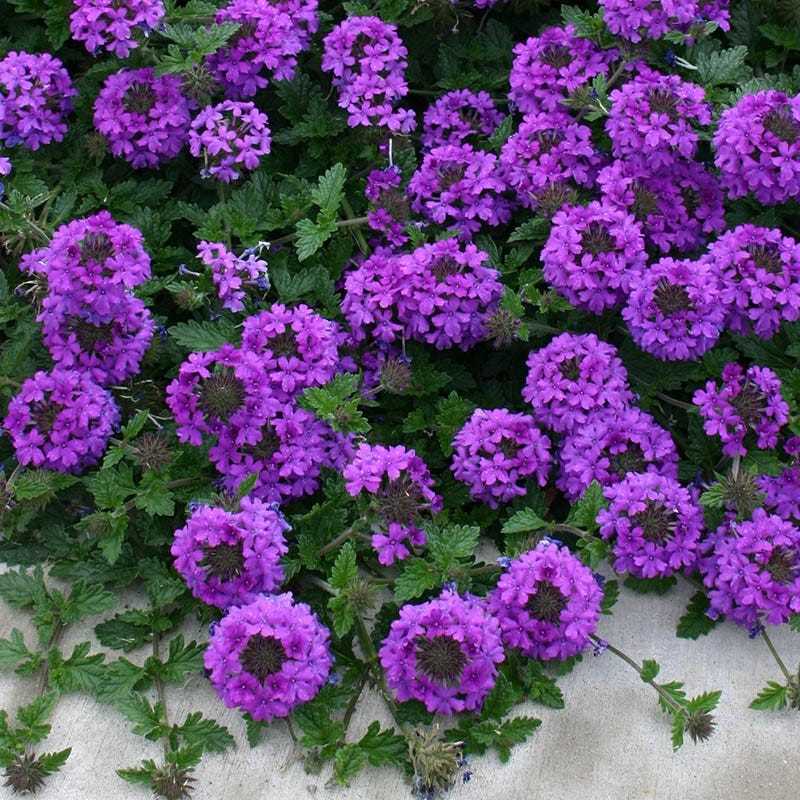

Applying a layer of mulch around your verbena plants can help conserve moisture, suppress weed growth, and regulate soil temperature. Use a 2-3 inch layer of organic mulch, such as wood chips or shredded bark, and spread it evenly around the base of the plants.
8. Winter Care
In regions with cold winters, it is important to protect your verbena plants from frost and freezing temperatures. Cut back the plants to about 4-6 inches above the ground after the first frost. Cover the root zone with a thick layer of mulch to insulate the plants and prevent frost damage.
By following these proven techniques, you can ensure that your verbena plants remain healthy, vigorous, and beautiful throughout the growing season. With proper care, your verbena plants will reward you with a profusion of colorful flowers and delightful fragrance.
Questions and Answers:
What are the different types of verbena plants?
There are several different types of verbena plants, including Verbena bonariensis, Verbena rigida, Verbena canadensis, and Verbena hastata. Each type has its own unique characteristics and growing requirements.
How do you grow verbena plants in the garden?
To grow verbena plants in the garden, you should choose a sunny location with well-drained soil. Plant the verbena seeds or seedlings in the spring after the danger of frost has passed. Water the plants regularly and deadhead the flowers to encourage continued blooming.
What are the best companion plants for verbena?
Some great companion plants for verbena include petunias, marigolds, gazanias, and zinnias. These plants not only look beautiful together, but they also share similar growing requirements, making them a good match in the garden.
Can verbena plants be grown in containers?
Yes, verbena plants can be grown in containers. Choose a container with drainage holes and use a well-draining potting mix. Place the container in a sunny location and water the verbena regularly. Make sure to fertilize the plants every few weeks to keep them healthy.
What are the benefits of growing verbena plants?
Growing verbena plants in the garden can have several benefits. They attract pollinators like bees and butterflies, adding beauty and life to your garden. Verbena plants also come in a variety of colors, making them a versatile and vibrant addition to any garden.
How often should I water my verbena plants?
Verbena plants should be watered regularly to keep the soil evenly moist. During hot and dry periods, you may need to water the plants more frequently. However, be careful not to overwater, as verbena plants don’t like soggy soil.
How do you propagate verbena plants?
Verbena plants can be propagated through stem cuttings or by dividing mature plants. To propagate through stem cuttings, take a 4- to 6-inch cutting from a healthy verbena plant, remove the lower leaves, and place the cutting in a pot with moist potting soil. Keep the soil consistently moist until roots develop. To divide mature plants, carefully lift the plant from the ground, separate the rootball into smaller sections, and replant each section in a new location.







